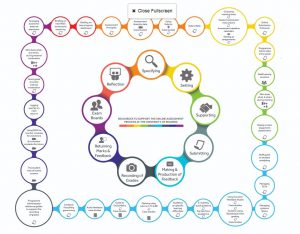
Emily Parsons is a Senior Programme Administrator in the School of Agriculture, Policy and Development (SAPD). Online assessment has been adopted throughout the SAPD, impacting academic and non- academic colleagues. In this case study, Emily outlines the experiences of her Support Centre team working with SAPD as an Early Adopter School.
OBJECTIVES
To reduce the administrative burden of assessment and improve the overall assessment experience for staff within the Support Centre whilst supporting change within the School.
CONTEXT
The University has a long-term vision to move toward online assessment, where practical, and improve underlying processes. SAPD became an Early Adopter School in May 2017 which allowed the EMA Programme to support a significant shift away from a mixture of online and offline marking to the full provision of online marking where practical. The SAPD Support Centre was involved right from the start working collaboratively with the EMA, TEL, CQSD and senior school leadership team during the change process. The Support Centre was one of the first to experience the impact on their working practices of a shift towards greater online marking throughout 2017-2018.
IMPLEMENTATION
As an Early Adopter School, SAPD undertook a full change programme to support online submission, feedback and grading as well as support for all underlying processes. A series of meetings and three major workshops lasting between three and four hours were held throughout the Summer involving all collaborating teams.
Initially only two members of the Support Centre team were involved but representation quickly expanded to include at least four members. It was really important to make sure that a range of professional staff views were being heard during the change planning stage particularly because all of these colleagues would play a role in implementing new processes and delivering change.
Each of these collaborative workshop meetings drew everyone together, in person, in one room instead of relying on e-mail correspondence. This proved far more effective. Relying on e-mail could have significantly delayed the process and may not have led to the kind of in depth, rich discussion around assessment practice, process and policy within the School that was seen at each meeting.
One of the triggers for these debates was the creation of a series of highly detailed process flow diagrams showing the end to end assessment process within the University. These process maps outlined who does what and when in four main diagrams – anonymous marking using the Blackboard marking tool, named marking using the Blackboard tool, anonymous marking using Turnitin, and named marking using Turnitin. These maps were essential to understanding the end to end process and for allowing the School to start thinking about consistent practices.
Following this approach to consistent practice professional staff also created a manual containing essential information such as how to set up submission points or Turnitin similarity reports in the way that the School wanted. All professional staff could then follow this detailed guidance. This proved essential to ensure that all colleagues were working in a similar way.
IMPACT
Two key areas of impact have been experienced within the Support Centre – the first surrounds the adoption of more consistent processes to deal with the submission, receipt, marking and moderation of coursework, and the second surrounds the significant increase in amount of work marked online.
The adoption of more consistent processes was made possible by the creation of the detailed process diagrams outlined above. These show the 45-50 steps involved from submission to final exam board agreement and confirmation, including who does what exactly, and when. The creation of these process diagrams during the Summer workshops, informed by all of the groups involved was, in itself, a useful exercise. We could take a step back and really think about how we could make this process as efficient and as effective as possible whilst keeping an element of flexibility to cover any type of submission or new requirement that we collectively hadn’t thought of!
During the workshops, the Support Centre, in collaboration with the School, was also asked to create a large assessment spreadsheet listing all submissions due to be submitted during the academic year. The creation of this detailed assessment spreadsheet, in itself, provided an opportunity for colleagues to pause and review the amount of assessment and the School’s use of different assessment types.
This was also a crucial starting point from which we could categorise assessment types (such as group work, individual essay, video submission) and then think through which of the two marking tools – Blackboard or Turnitin – would be most appropriate for each type. Both the process diagrams together with these spreadsheets helped to support workflow and planning within the Support Centres who then knew exactly what they had to do and when, for the full academic year.
Under the new, more consistent. processes, academic colleagues were no longer required to create submission points. This role was transferred to professional staff and actually represented one of the most significant changes undertaken. All submission points are now created in the same way -for example there is no longer any variation within the School surrounding student views of Turnitin reports as all students only see similarity reports after the submission deadline. In general, academic colleagues were happy to transfer the set-up of submission points to professional staff and just had to inform the Support Centre, in advance, when assessment was due. Around 400 pieces of assessment were due during 2017- 2018.
Alongside increased consistency surrounding processes, the School has seen significant increases in the amount of work submitted and marked online. Overall this change has improved the assessment experience for colleagues within the Support Centre in a number of ways:
• Previously, using a rota system, colleagues were allocated a time slot to sit in the front office to receive hard copies and process each paper coming in. This was an intense role and so reduced the time available to undertake any other supporting role. There is no need to do this in the current system as submission is managed online for almost all work. This represents a significant time saving for colleagues.
• At the end of the marking process, each paper would also have to be sorted alphabetically and placed in individual envelopes, ready for collection by students. This doesn’t happen now for the vast majority of pieces which are accessed online. In the past this role might have taken half a day. Now it takes an estimated 30 minutes for the small amount of assessment still marked in hard copy. The time saved has been described by professional staff within the team as “extraordinary”.
• This also means that the assessment process has become much more scalable. Support Centres can cope with increases in students without seeing significant increase in workload.
• The Support Centre used to ask academic colleagues to return marked work to them within 14 working days of submission to allow time for processing. There is no need to do this anymore because the marks and feedback are returned online so academic colleagues now have the full 15 working days to mark submitted work,
• The Support Centre is no longer drowning in a sea of paper leaving much more room and saving storage space. This was a particular problem when students failed to come back to collect their work.
• Some of the functions of the marking tools are saving a significant amount of time for the Support Centre. One example surrounds non-submission. It took a considerable amount of time to contact students who had failed to submit work when they were submitting hard copies. Now Turnitin allows professional staff to send one e-mail to all non-submitters easily and very quickly.
• Previously, in order to undertake internal moderation, Support Centre staff would release marks but keep the hardcopy coursework, which included their feedback, back from the students until internal moderation had taken place. After this point, the full feedback would also be released. In order to undertake external moderation, Part 2 and Part 3 students were asked to create a portfolio of their work, including marks and feedback, and submit this at the end of the academic year so that external examiners could review the work. Student engagement in this process was variable with some students having lost their work by this point. In addition, these processes generated a huge amount of paper and took a large number of working hours to manage. This isn’t necessary anymore, aside from a very small amount of fieldtrip work. Internal and external moderators can access both marks and feedback quickly and easily online, from wherever they are in the country.
REFLECTIONS
Moving the School towards more consistent approaches to managing assessment and increasing online marking and feedback has largely been a very positive experience for the Support Centre. We are now enjoying a range of benefits which have made our role within the assessment cycle much more manageable.
We had worried that some areas of work might increase – for example, we might have seen more reported cases of academic misconduct as a result of much greater use of Turnitin similarity reports. This has not occurred but the School had been undertaking a significant amount of work in this area including the introduction of a formative piece of work at Part 1 and at the start of the MSc programmes which is then analysed during follow on seminars.
As we move forward into the next academic year, there are still some areas that we need to think about a little more. We’ve discovered through this processes, for example, that there are multiple different ways in which academic colleagues assess and give feedback on presentations. We need to work on understanding the processes in this area more in 2018-2019.
This year we will also be able to start the process of collecting new assessment data and deadlines much earlier. This will enable us to create submission points around July and August. This will place us in a better position to plan ahead for 2018-2019.



 The Department of English Literature (DEL) is organising student focus groups as part of our TLDF-funded ‘Diversifying Assessments’ project led by Dr Chloe Houston and Dr Madeleine Davies. This initiative is in dialogue with Curriculum Framework emphases engaging students in Programme Development and involving them as stakeholders. This entry outlines the preparatory steps taken to set up our focus groups, the feedback from the first meeting, and our initial responses to it.
The Department of English Literature (DEL) is organising student focus groups as part of our TLDF-funded ‘Diversifying Assessments’ project led by Dr Chloe Houston and Dr Madeleine Davies. This initiative is in dialogue with Curriculum Framework emphases engaging students in Programme Development and involving them as stakeholders. This entry outlines the preparatory steps taken to set up our focus groups, the feedback from the first meeting, and our initial responses to it.




 This entry describes the use of online Learning Journals on a Part Three English Literature module. This method of assessment supports students to carry out independent research and to reflect on their personal learning journey, and rewards students’ sustained engagement and progress.
This entry describes the use of online Learning Journals on a Part Three English Literature module. This method of assessment supports students to carry out independent research and to reflect on their personal learning journey, and rewards students’ sustained engagement and progress.
